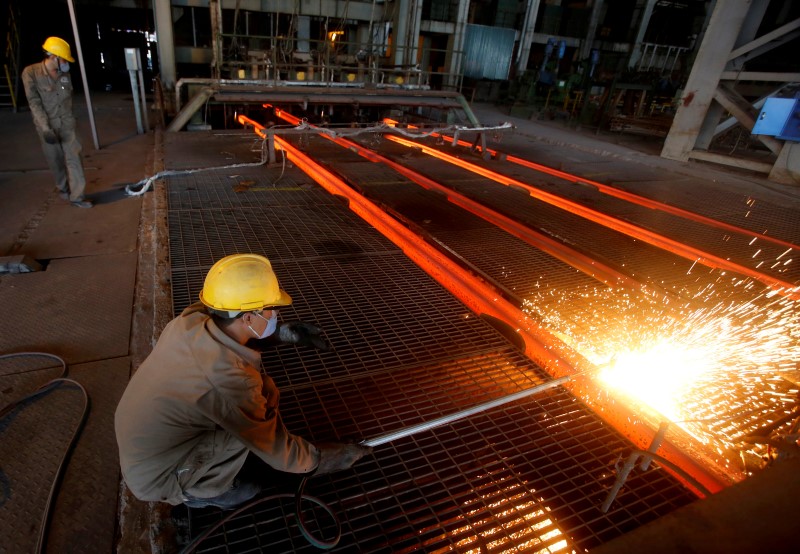By My Pham and Khettiya Jittapong
HANOI/BANGKOK (Reuters) - As a construction boom spurs steel demand across Southeast Asia, countries such as Vietnam, Indonesia and Thailand are challenging a flood of imports from China by retooling their steelmaking technology or imposing tariffs.
U.S. and European steelmakers are leading complaints over alleged dumping, but cheap Chinese imports account for two thirds of steel consumed in many Southeast Asian countries. The region includes six of the top 10 buyers of Chinese steel, and capacity utilisation in its own mills has slumped to less than 40 percent.
While steel from China is expected to dominate for many years, swelling demand is driving efforts in countries like Vietnam and Indonesia to build more modern plants to better compete with China's vast mills.
"China is a major force with huge supply dominating the world, but we have solutions to deal with it," Tran Tuan Duong, general director of Vietnam's biggest steel firm Hoa Phat Group (HM:HPG), told Reuters.
Hoa Phat aims to triple production capacity to up to 6 million tonnes over 5-10 years using modern blast furnace technology.
The local unit of Taiwan's Formosa Plastics Group (TW:1301) has begun work on a $10.6 billion (£7.1 billion) steel complex in Ha Tinh province with an initial annual crude steel capacity of 7 million tonnes, although this month's planned start-up of the initial phase has been delayed by an environmental dispute.
TRADE TENSIONS
China has raised global trade tensions as its steel exports have soared, with surplus capacity estimated at more than 300 million tonnes, or triple Japan's annual output.
Steelmakers in Southeast Asia have been hit hard as many of the region's electric arc furnace plants, which use scrap as their raw material, are unable to compete with Chinese blast furnaces using far cheaper iron ore.
Many electric arc furnace plants have been idled and capacity utilisation across the 10-member Association of Southeast Asian Nations (ASEAN) grouping has fallen to less than 40 percent from around 65 percent following a 2010 regional free trade agreement with China that cut tariffs on a raft of goods, including steel, said Roberto Cola, president of the ASEAN Iron and Steel Council.
Hoa Phat's Duong said Vietnam could compete with other Southeast Asian countries.
"But the trade deal is plus C, which means including China, and all troubles come from that," he said.
Vietnam was the second-biggest market for Chinese steel in 2015, with imports of 10.11 million tonnes, according to UK consultancy MEPS. Its own steel output that year stood at just 6.1 million tonnes, World Steel Association data showed.
"With Southeast Asia as a whole it's a bit of a chicken and egg situation," said MEPS analyst Jeremy Platt. "The cheap imported steel is benefiting their economic development, but it is hindering the ability to develop their steelmaking sector."
TARIFFS RISE
Several countries are introducing tariffs to protect local industry.
Vietnam in March imposed temporary anti-dumping tariffs ranging from 14 percent to 23 percent on steel imports from China and elsewhere. It slapped additional import duties of up to 25 percent on more Chinese steel products that last until October 2019.
Thailand's commerce ministry is working on the final draft of an anti-dumping law and expects to propose the draft for approval by end-2016, a spokeswoman said.
The moves come as local steelmakers hope to cash in on an expected jump in demand.
Indonesia and the Philippines face a huge backlog in infrastructure, said the ASEAN Iron and Steel Council's Cola, with steel consumption in ASEAN forecast to reach 80 million tonnes by 2018 from 70 million tonnes last year.
Indonesia's Krakatau Steel (JK:KRAS) is building a blast furnace with a capacity of 1.2 million tonnes west of Jakarta, which it expects will be completed shortly.
Vietnam's steel consumption surged 34 percent in the first five months of 2016, and demand is expected grow at more than 10 percent a year over the next decade as rapid economic growth fuels infrastructure development, said Hoa Phat's Duong.
Steelmakers' share prices have risen in anticipation. Vietnam's Hoa Phat Group has climbed 35 percent this year, smaller rival Hoa Sen (HM:HSG) has gained 94 percent, and Krakatau Steel has rallied 123 percent.
In Thailand, steelmakers expect the first annual growth in demand in three years as the government begins work on over $50 billion in infrastructure projects. Shares of Tata Steel (Thailand) Pcl
A unit of India's Tata Steel Group and Thailand's largest steel producer, the firm cancelled some shipments from Thailand to India in April to supply the metal to the Thai market.

"We have seen signs of improving demand for steel, mainly from the government projects including city rail and road projects," said Rajiv Mangal, chief executive of Tata Steel's Thai unit, who sees sales rising 10 percent this year.